
Last updated 4/2025
Created by BHM Engineering Academy,Israel Gbati
MP4 | Video: h264, 1280×720 | Audio: AAC, 44.1 KHz, 2 Ch
Level: Intermediate | Genre: eLearning | Language: English | Duration: 118 Lectures ( 11h 28m ) | Size: 5.1 GB
Standards-Compliant Firmware with MISRA C++, AUTOSAR, DO-178C, ISO 26262, and IEC 61508
What you’ll learn
Apply ISO 26262, MISRA C++ and AUTOSAR,standards to real-world safety-critical embedded projects.
Avoid undefined, unspecified, and implementation-defined behaviors in safety-critical C++ code.
Design deterministic error handling strategies using RAII, noexcept, and static memory techniques.
Design Robust Architectures: Build safe, modern C++ embedded systems from scratch.
Lead and manage safety-critical firmware projects with technical excellence and compliance expertise.
Requirements
NUCLEO-F411
Description
In today’s hyper-connected, technologically driven world, the margin for error in embedded systems is virtually zero.
Imagine a scenario where a single software glitch could jeopardize an aircraft’s safe landing, disrupt critical automotive functions, or even compromise life-saving medical devices.
Now imagine having the knowledge to design, develop, and verify such systems. Welcome to Mastering Safety-Critical Systems in Embedded C++—an advanced program carefully created for engineers who demand excellence and are ready to redefine industry standards.
Why This Course Matters
Safety is Non-Negotiable
In domains ranging from aerospace and automotive to medical and industrial automation, safety-critical systems are the backbone of modern technology.
Your expertise in designing firmware that operates flawlessly, deterministically, and securely can literally save lives. If you’ve ever hesitated, wondering how to ensure your code meets the most rigorous safety standards, this course is your first step.
Learning Outcomes and Career Benefits
By the end of this comprehensive program, you will be able to
Apply Industry Standards such as ISO 26262, MISRA C++, AUTOSAR Guidelines, JSF, and SEI CERT practices in real-world projects.
Design and Architect safety-critical embedded software from the ground up using modern C++.
Implement Deterministic Error Handling and resource management techniques including RAII, noexcept, and static memory allocation.
Verify and Validate your designs with advanced V&V techniques, ensuring full compliance with rigorous certification standards.
Lead Safety-Critical Projects confidently, with the technical acumen and managerial prowess demanded by the most challenging environments.
Course Outline Summary
Module: Introduction to Safety-Critical Embedded Systems
Defining Safety-Critical Embedded Software: Understand the critical role of safety in automotive, aerospace, medical, and industrial applications.
Key Standards Overview: Dive into ISO 26262, MISRA C++, and AUTOSAR Guidelines.
Real-World Case Studies: Explore case studies from industries worldwide.
Module: C++ in Safety-Critical Systems
Evolution from C to Modern C++: Learn why modern C++ is essential in safety-critical environments.
Coding Guidelines Adoption: Understand differences between standard and safety-critical embedded software and why standards like MISRA are crucial.
Module: Safety-Critical Coding Standards
In-Depth MISRA and AUTOSAR Analysis: Compare MISRA C++:2008/2023 with AUTOSAR C++14 guidelines.
Standards Reconciliation: Delve into JSF, SEI CERT, and HIC++ with real-world case studies.
Module: Exception Safety in Embedded C++
Zero-Cost Abstractions and the “noexcept” Keyword: Grasp best practices for exception-safe function design.
Alternatives to Traditional Exceptions: Learn deterministic error handling for embedded systems.
Module: Memory Management for Safety-Critical C++
Avoiding Dynamic Memory Allocation: Implement static and stack-based memory management.
RAII and Resource Management: Master the rules of zero, three, five, and six for safe resource allocation.
Module: Safe Use of Modern C++ Constructs
Restricted Use of Inheritance and Polymorphism: Leverage safe coding patterns for maintainability.
Strongly-Typed Enums and Constexpr: Ensure enhanced safety and compile-time validations.
Module: Avoiding Undefined, Unspecified, and Implementation-Defined Behavior
Identifying and Mitigating Risks: Eliminate dangerous coding practices using static analysis tools.
Writing Portable and Safe Code: Ensure consistency across various compilers.
Target Audience and Prerequisites
This course is carefully designed for
Embedded Engineers
Technical Leads and Architects: Responsible for system design and certification in safety-critical domains.
Prerequisites: A basic understanding of embedded C/C++ programming), and a keen interest in industry safety standards.
Industry Growth: The embedded systems market is projected to grow at a CAGR of approximately 5–7% over the next five years.
Salary Potential: Professionals with advanced safety-critical skills typically earn between $100K–$150K+ annually, depending on region and experience.
Demand Surge: Companies in automotive, aerospace, and healthcare are increasingly prioritizing safety-critical systems, driving demand for top talent.
The demand for safety-critical expertise is accelerating. Every day, companies are struggling to meet stringent regulatory standards while pushing the envelope of technology. Delay no longer!
转载请注明:0daytown » Safety-Critical Embedded C++ Firmware Development
 Password/解压密码www.tbtos.com
Password/解压密码www.tbtos.com